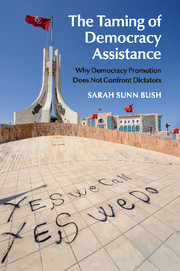Book contents
- Frontmatter
- Contents
- List of figures
- List of tables
- Preface
- List of abbreviations
- Part I Introduction and argument
- Part II Testing the argument
- 4 Delegation and the allocation of democracy assistance
- 5 Changes in American grant-making
- 6 Creating the democracy establishment
- 7 Jordan: aid in the shadow of geopolitics
- 8 Tunisia: reform after revolution
- Part III Conclusions
- Part IV Appendices and references
5 - Changes in American grant-making
from Part II - Testing the argument
Published online by Cambridge University Press: 05 May 2015
- Frontmatter
- Contents
- List of figures
- List of tables
- Preface
- List of abbreviations
- Part I Introduction and argument
- Part II Testing the argument
- 4 Delegation and the allocation of democracy assistance
- 5 Changes in American grant-making
- 6 Creating the democracy establishment
- 7 Jordan: aid in the shadow of geopolitics
- 8 Tunisia: reform after revolution
- Part III Conclusions
- Part IV Appendices and references
Summary
Speaking out … for democratic values and principles is good and right. But it's not just good enough. We must work hard for democracy and freedom.
Building democracy is like building a bridge: It's something that today we think there aren't too many ways to do well.
In 1982, President Ronald Reagan elaborated his vision for democracy promotion in an address to the British parliament: “to foster the infrastructure of democracy – the system of a free press, unions, political parties, universities – which allows a people to choose their own way, to develop their own culture, to reconcile their own differences through peaceful means.” Reagan followed through by proposing two new democracy promotion vehicles to Congress: Project Democracy, a public diplomacy program that the US Information Agency would coordinate, and the National Endowment for Democracy, a bipartisan grants program. Project Democracy failed to win Congressional support, but the NED succeeded. The NED sought to make democracy assistance public after controversial, covert actions conducted by the CIA during the Cold War. The NED was modeled on the Stiftungen, the German political-party foundations that aided Spain and Portugal's democratic transitions.
If the transnational theory of democracy assistance advanced in this book is correct, then increasing competition and professionalism in the democracy establishment should have “tamed” American aid over time. Yet demonstrating such a trend is challenging. The past three decades have witnessed major changes in global politics as a consequence of the end of the Cold War, as well as widespread democratization. Those changes are likely to affect states’ democracy promotion strategies in multiple ways. Consequently, it is difficult to show that competition and professionalization in the democracy establishment independently tamed democracy assistance.
To cope with that challenge, this chapter uses multivariate statistical analysis to examine how competition and professionalization affect programs that have been funded in a largely constant manner over time.
- Type
- Chapter
- Information
- The Taming of Democracy AssistanceWhy Democracy Promotion Does Not Confront Dictators, pp. 106 - 130Publisher: Cambridge University PressPrint publication year: 2015

